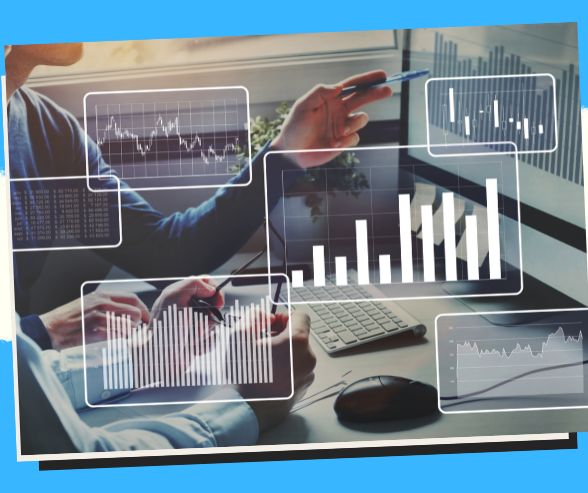
Data Analytics: The Game Changer in Modern Business Decision-Making! 

Unlocking Success: The Impact of Data Analytics on Modern Business Decision-Making 

In the ever-evolving landscape of modern business, one tool has risen to the forefront, becoming indispensable for informed, strategic decision-making: Data Analytics.
In this comprehensive guide, we will explore the pivotal role data analytics plays in shaping the future of business. Whether you’re a seasoned executive, a budding entrepreneur, or simply curious about how data transforms the corporate world, this article will be your guide. So, fasten your seatbelts as we embark on a data-driven journey into the heart of modern business decision-making.
The Data-Driven Revolution
Before we dive into the nitty-gritty of data analytics, let’s take a moment to appreciate the significance of this transformational force in the business world.





What is Data Analytics?
Let’s start with the basics. What exactly is data analytics?
Data analytics is the process of examining, cleansing, transforming, and interpreting data to uncover valuable insights, patterns, and trends. It encompasses a spectrum of techniques, ranging from basic data exploration to advanced statistical modeling and machine learning.
The primary goal of data analytics is to transform raw data into actionable insights that can guide business decisions. It’s not just about collecting data; it’s about turning that data into a strategic asset.
The Evolution of Data Analytics
Data analytics has come a long way since its inception. Let’s take a brief journey through its evolution:




The Data Analytics Process
To demystify data analytics, let’s break it down into a series of steps:
- Data Collection: The journey begins by collecting data from various sources—customer databases, social media, sensors, you name it. The more diverse the data, the richer the insights.
- Data Cleaning: Raw data is often messy. Cleaning involves removing duplicates, correcting errors, and handling missing values. It’s like tidying up before a big event.
- Data Exploration: This is where analysts play detectives. They use visualization tools like charts and graphs to uncover patterns, correlations, and outliers in the data.
- Data Transformation: Sometimes data needs a makeover. Transformation involves aggregating, summarizing, or reshaping data to make it suitable for analysis.
- Data Analysis: Here comes the magic. Analysts apply statistical techniques, machine learning algorithms, and other analytical tools to the data. The goal is to extract meaningful insights and draw conclusions.
- Data Visualization: It’s showtime. Data visualization helps convey complex information in a clear and understandable manner. Think of it as storytelling with charts and graphs.
- Data Interpretation: Analyzed data is like a puzzle. Analysts put the pieces together, drawing actionable insights and recommendations. It’s the “Aha!” moment.
- Reporting: The findings are presented to decision-makers through reports or dashboards. These reports serve as the compass for informed decision-making.
- Continuous Improvement: Data analytics is an ongoing process. Feedback and new data lead to refinements and improvements in future analyses.
Data Analytics in Action
So, how does data analytics manifest in real-world scenarios? Let’s explore some examples:
- Retail: Retailers use data analytics to optimize pricing, inventory management, and personalized marketing. Ever wondered why you receive tailored product recommendations online? That’s data analytics at work.
- Healthcare: Healthcare providers leverage analytics to improve patient care, streamline operations, and predict disease outbreaks. Analytics can identify high-risk patients who need intervention, saving lives and resources.
- Finance: Financial institutions rely on data analytics for fraud detection, risk assessment, and investment strategies. Credit scoring, for instance, is a result of sophisticated analytics.
- Manufacturing: Manufacturers use analytics to enhance production processes, reduce downtime, and improve quality control. Predictive maintenance, powered by data analytics, can prevent costly equipment breakdowns.
- Marketing: Marketers harness data analytics to personalize campaigns, track customer engagement, and measure the effectiveness of advertising efforts. You see those eerily relevant ads? Yep, that’s data analytics too.
- E-commerce: Online retailers employ analytics to recommend products, analyze customer reviews, and optimize the user experience. That “Customers who bought this also bought” section? It’s backed by data.
- Energy: Energy companies apply data analytics to monitor power grids, optimize energy consumption, and predict equipment failures. This leads to more reliable and efficient energy supply.
- Education: Educational institutions use data analytics to enhance student performance, allocate resources efficiently, and tailor curricula to individual needs. It’s all about improving the learning experience.
- Transportation: Transportation companies optimize routes, manage fleets, and enhance customer service through data analytics. Those ride-sharing apps with estimated arrival times? Data analytics powers them.
- Government: Governments use data analytics to analyze citizen data, allocate resources efficiently, and make data-driven policy decisions. It’s all about serving the public better.
The Power of Business Intelligence (BI)
Data analytics and business intelligence (BI) are often mentioned together, but they serve different purposes. While data analytics focuses on the analysis of data, BI complements it by providing tools and processes for data management, reporting, and decision support.


boards that provide real-time insights into key performance indicators (KPIs). These visualizations make complex data easily digestible.




BI tools like Microsoft Power BI, Tableau, and QlikView have become essential for organizations looking to leverage data for competitive advantage.
Challenges and Considerations
While data analytics and BI offer immense benefits, they also come with challenges:






The Future of Data Analytics
The world of data analytics is not static; it’s in a constant state of evolution. Here are some trends shaping its future:






Conclusion
In the grand scheme of modern business, data analytics isn’t just a tool; it’s the compass guiding decision-makers through uncharted territories. The data-driven revolution has transformed industries, redefined competition, and empowered organizations to make more informed, strategic choices.
Whether you’re a business leader steering a multinational corporation or an entrepreneur navigating the tumultuous waters of a startup, data analytics is your ally in the quest for success. It empowers you to understand your customers, optimize your operations, and see the future before it unfolds.
So, embrace data analytics, foster a culture of data-driven decision-making, and watch your business flourish in the age of information. The data-driven future awaits, and it’s yours to seize.
Related Queries
The Role of Data Analytics
Data-Driven Decision-Making
Unlocking Business Success
Maximizing Business Potential
Data to Dollars
Digital Revolution in Business
Business Brilliance with Data
Mastering Data Analytics
Decoding Data for Decisions
Supercharge Your Business with Data
Save/Share this story with QR CODE
Disclaimer
This article is for informational purposes only and does not constitute endorsement of any specific technologies or methodologies and financial advice or endorsement of any specific products or services.
 Need to get in touch?
Need to get in touch?

We appreciate your reading. 
1.) 

Your DONATION will be used to fund and maintain NEXTGENDAY.com
Subscribers in the Philippines can make donations to mobile number 0917 906 3081, thru GCash.
3.) 
4.) 
AFFILIATE PARTNERS

World Class Nutritional Supplements - Buy Highest Quality Products, Purest Most Healthy Ingredients, Direct to your Door! Up to 90% OFF.
Join LiveGood Today - A company created to satisfy the world's most demanding leaders and entrepreneurs, with the best compensation plan today.











